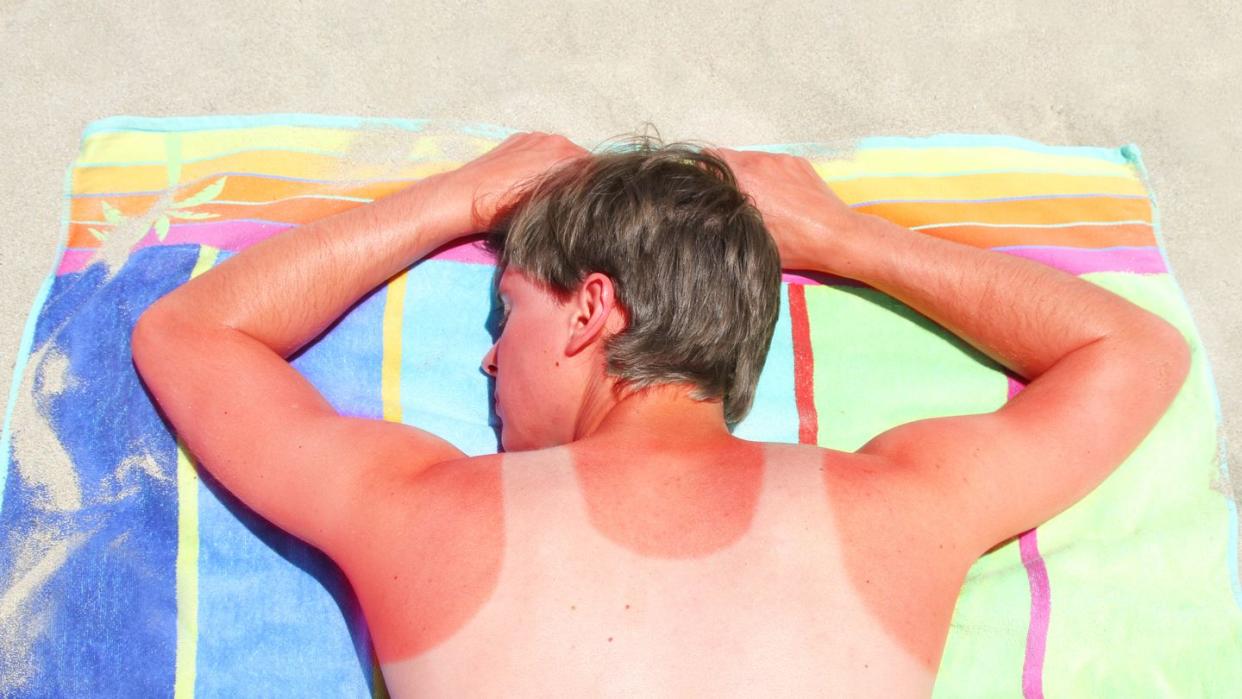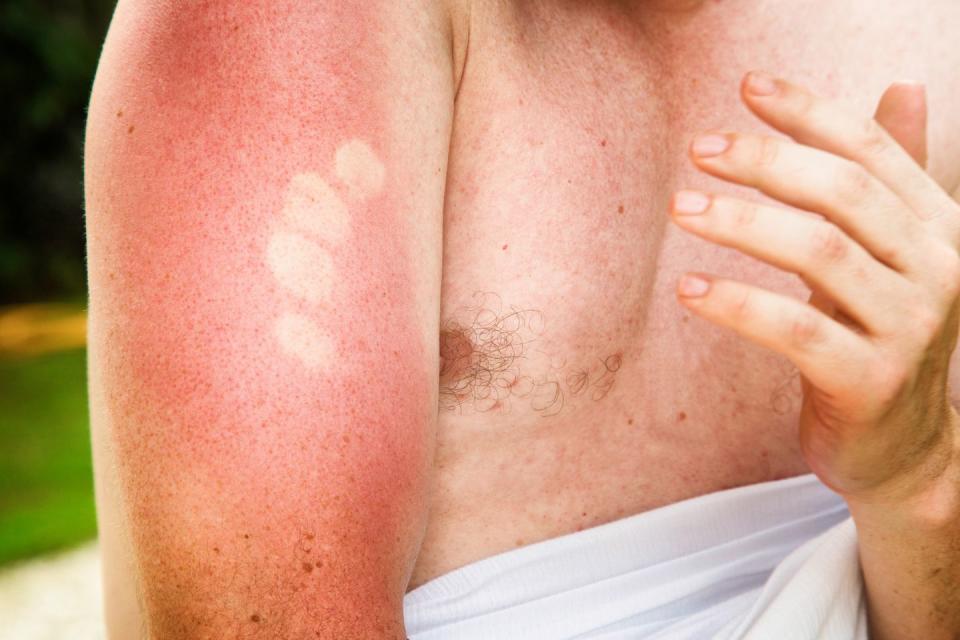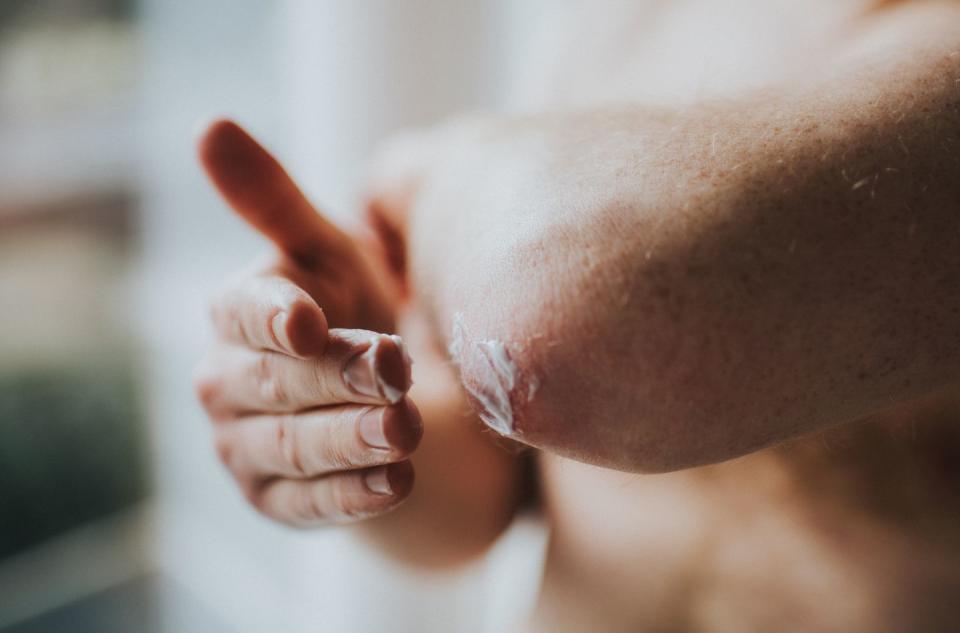6 Ways to Soothe a Sunburn, According to Dermatologists

THE BEST WAY to deal with a sunburn is to not get one in the first place. But sometimes they're inevitable, especially if you spend even a short amount of time outside and forgot to protect yourself with sunscreen.
More than a third of adults said they got a sunburn in 2023, the highest number reported in three years, according to a recent American Academy of Dermatology survey. And, a third of those said their sunburn was so severe that their clothing was uncomfortable to wear—a response that was most common among men.
“By definition, a sunburn is too much skin damage induced by the sun’s ultraviolet rays resulting in redness, peeling, swelling, and even blistering,” says Kenneth Mark, M.D., a cosmetic dermatologist in New York City, who specializes in Mohs skin cancer surgery.
That's uncomfortable and it's bad for you in the long term. Any kind of sunburn damages the DNA in your skin cells, which can lead to mutations that cause skin cancer, says Kavitha Reddy, M.D., director of dermatologic surgery at Boston University School of Medicine.
Skin cancer is one of the most common cancers in the U.S., and one in five Americans will develop it by age 70. Melanoma, the most deadly form of skin cancer, is rising in younger men.
So proper use of sunscreen is key. (Here’s a list of the best sunscreen options.) Always choose one that’s SPF 30 or higher and broad-spectrum, meaning it protects you from UVA and UVB rays, according to the AAD. Reapply it at least every two hours; more often if you’re swimming or sweating.
“I emphasize the need to reapply after sweating and swimming even if the sunscreen you are using says it is waterproof,” Dr. Mark says. Despite taking precautions, if you do get a sunburn, there are some ways to soothe it.
Why is a sunburn so dangerous?
The sun’s ultraviolet radiation causes damage to your skin cells and mutations in the cells’ DNA, Dr. Mark says. This can lead to premature aging of the skin—along with wrinkles and hyperpigmentation—as well as increase your risk for skin cancer.

So a sunburn is more than just having red, painful skin, he emphasizes.
“The damage caused by a sunburn is not just what you see, but it also causes DNA damage, which can lead to pre-cancers and skin cancers down the road,” Dr. Mark says.
Getting five or more sunburns can raise your risk for melanoma, according to the Skin Cancer Foundation. Childhood sunburns are one of the biggest risk factors for melanoma, Dr. Mark adds.
How to Soothe a Sunburn
When you’re outside and notice your skin feels hot or painful—like it’s burning—or see it start to turn pink or red, that’s your cue to get inside. Staying outside in the sun after this point will only make your burn worse, since you’ll prolong your UV exposure, according to Dr. Reddy.

It can take a few days or about a week for your skin to heal. In the meantime, here are some tips for taking care of your sunburn:
Take a Pain Reliever
As soon as you can, take an NSAID (non-steroidal anti-inflammatory drug) pain reliever like ibuprofen, Dr. Mark says.
These drugs work by fighting inflammation, Dr. Reddy adds, which can help you feel more comfortable, as well as minimizie some of the redness and swelling.
Hop into a Cool Shower
There's a myth that a hot shower can help ease sunburn pain—definitely don't do that! The opposite is actually true: Take a cool shower or bath to ease the burning sensation.
“Cool water decreases excess blood flow to the skin, which will help reduce inflammation and redness,” Dr. Reddy says. Stick to cool showers on the lowest pressure possible or soak in a cool tub, until your skin has healed. When you get out of the tub or shower, gently pat your skin dry and apply moisturizer.
If the burn is only on a small part of your body, like your face or your shoulders, a cool compress will work, too. Dr. Mark recommends a cool milk compress.
Just avoid putting ice directly on your burn—it can irritate your skin and even cause frostbite.
Moisturize Your Skin
Keep your skin well-moisturized while your sunburn heals (and, all the time, really). Moisturizing is key: Sunburns dry out your skin by damaging its outermost layer and making it more susceptible to water loss, Dr. Reddy says.
Choose products containing soothing ingredients, like aloe, soy, oatmeal, or vitamin E. Products like these rehydrate your skin, which makes the tightness and itching feel better.
“Aloe is incredibly soothing and facilitates healing due to its anti-inflammatory properties,” Dr. Mark says. “Vitamin E is an antioxidant, anti-inflammatory, and provides sun-protective effects.”
Avoid gel forms of these products, which may contain alcohol and could sting or dry out your skin, he adds.
Apply an Ointment
An over-the-counter 1 percent hydrocortisone cream can also help soothe your sunburn, Dr. Mark says, adding that it’s safe to use on your face. This medication can minimize itching, swelling, and redness.
Steer clear of any lotions or creams with ingredients like benzocaine (or other ingredients that end in “-caine”), the AAD says. These products can irritate your burned skin or possibly trigger an allergic reaction.
Drink Lots of Water
If you’ve spent lots of time in the sun, you could be at risk for dehydration. So it’s crucial to drink lots of water, Dr. Reddy says. Drinking water will also hydrate your skin from the inside.
The AAD says sunburns draw fluid from the surface of the skin away from the rest of the body to the skin, so it’s vital to replenish these fluids.
Don't Irritate Your Skin While It Heals
While your burn is healing, try not to do anything to irritate it more.
Don't pick at peeling skin or pop blisters, however tempting it may be. Blisters help your skin heal, and popping them could raise your risk for infection, according to AAD.
Avoid scrubbing your skin or wearing rough fabrics, and don’t scratch your burn, Dr. Reddy adds.
“The absolute most important thing is to avoid the sun in order to not add insult to injury,” Dr. Mark says. “A sunburn is a sign of significant damage to the skin and additional sun on the area when it is extra vulnerable dramatically increases the risk of future skin cancers as well as additional pain.”
When a Sunburn Is an Emergency
See a doctor if your sunburn is extremely blistered and red—and you can’t get relief after taking an NSAID, moisturizing, or taking a cool bath, Dr. Mark says. Doctors can prescribe a topical steroid which can speed up healing.
Also, seek medical attention if your sunburn isn’t getting better after a week, Dr. Reddy says. Head to the emergency room if you have severe pain, fever, chills, nausea, or vomiting, she adds. These could be signs of sun poisoning, and you might need antibiotics, steroids, or intravenous fluids.
You Might Also Like

